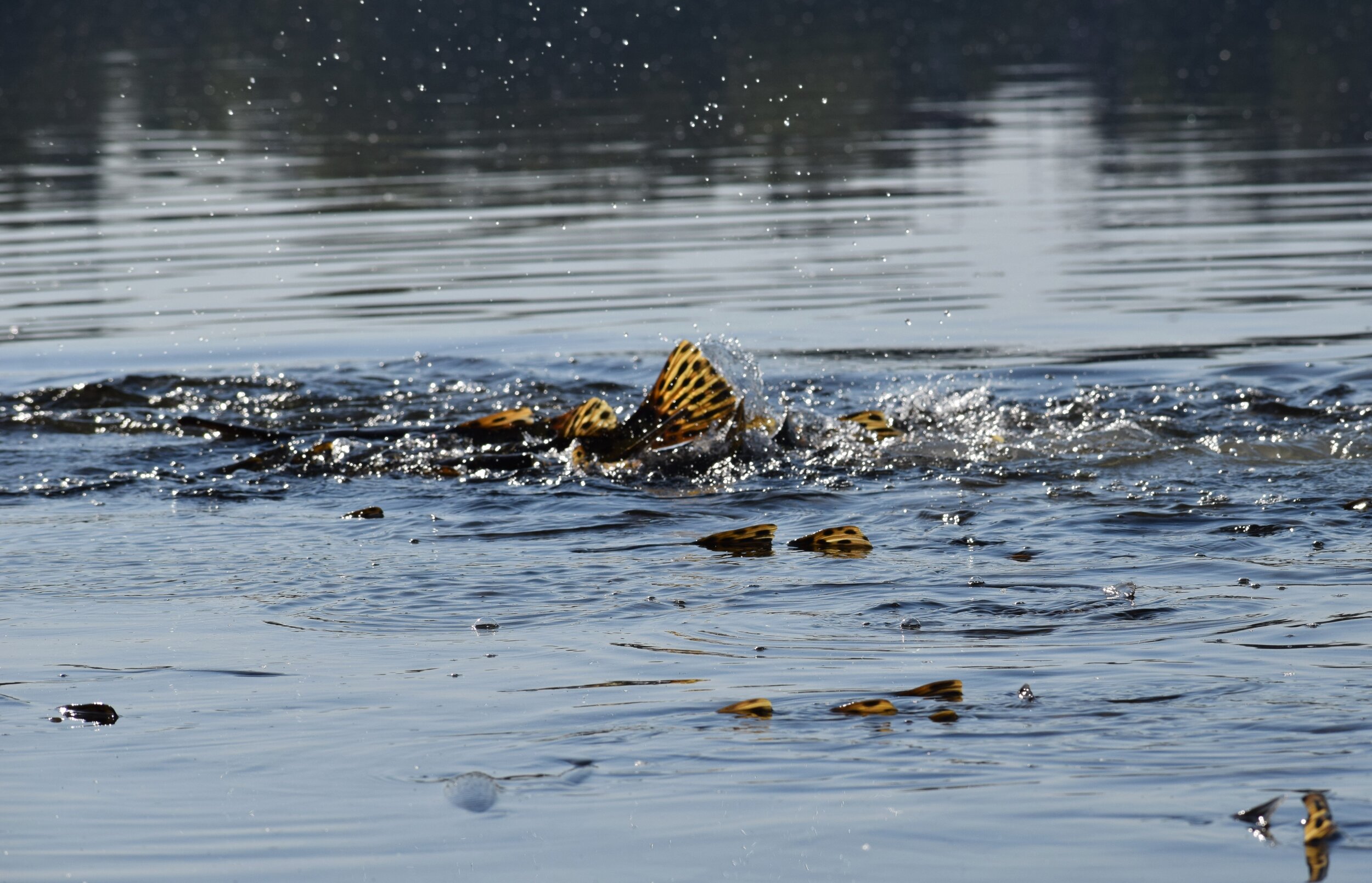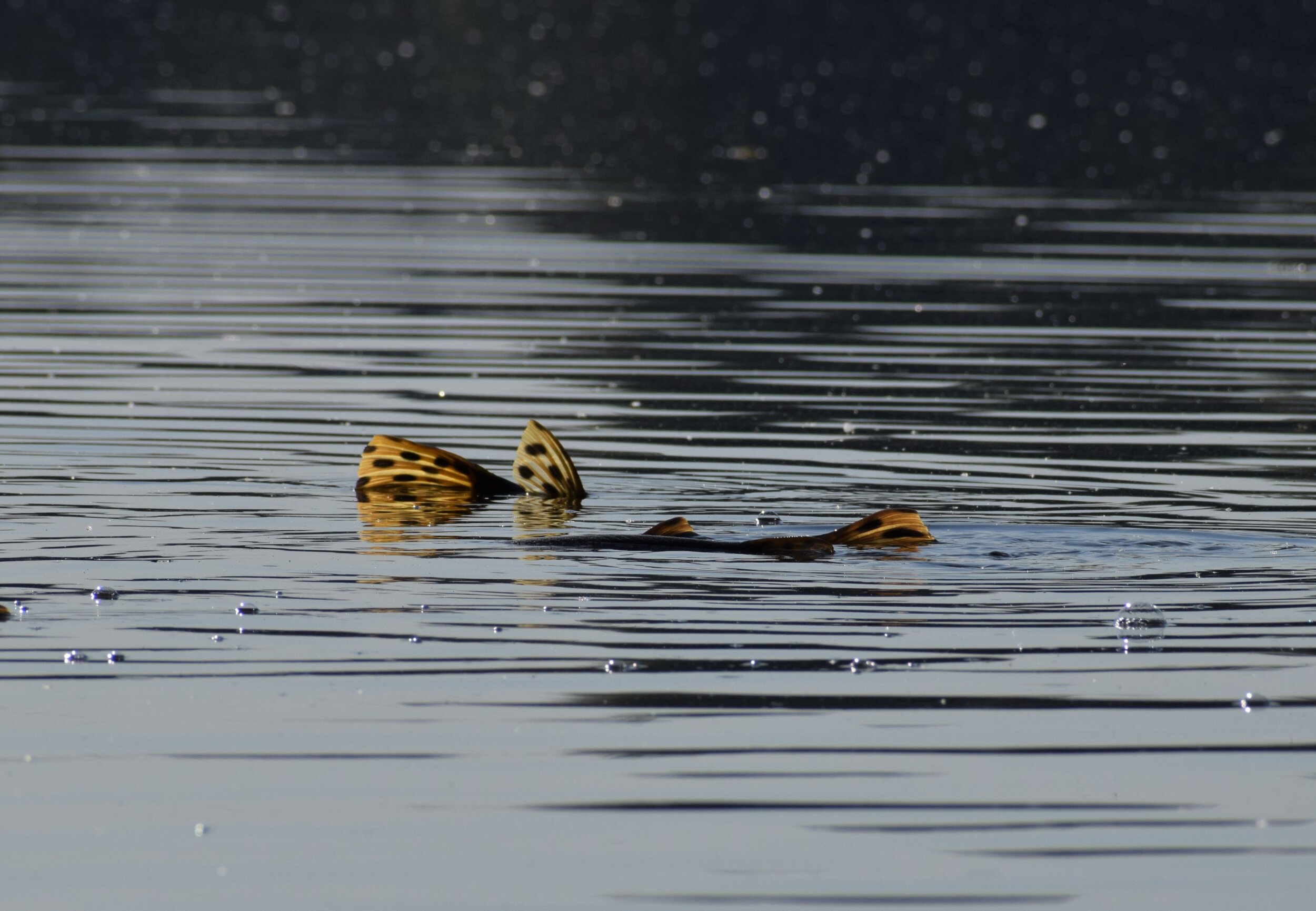Swimming Upstream: Seeing Fish in the Cataraqui River
I don’t know much about fish, or fishing. Yes, when I was a small child, my father helped me put worms on a hook from time to time and we would catch a sunfish or a rock bass, and let it go. But it seemed more like something he thought he should do as part of raising a kid than something he was really into. My mother is allergic to most fish. I eat fish, sometimes, but am less and less comfortable with the ethical and environmental cost of commercial fishing. The main point is that overall, in my life so far, I just haven’t thought much about fish. When swimming or skiing or kayaking on a lake or creek, I’ve been more oriented to looking up and around, at birds I can see or hear, or at plants I can name or smell.
But lately, it’s different.
Instead of seeing the surface of water as a mirror, I am starting to try to see it as a window. Who is down there? I wonder about that a lot now.
I think it goes back to two authors. They’re an odd couple: a contemporary Indigenous philosopher, and an eighteenth-century French military engineer.
Leanne Betasamosake Simpson has an article about precolonial treaties — about how Indigenous people had a long practice of treaty-making before encountering Europeans. The Mississauga Anishinaabe, for example, had a treaty with the Haudenosaunee you might have heard of, called the “Dish with one Spoon.” “Indigenous peoples understood these agreements in terms of relationship,” Simpson writes, “and renewal processes were paramount in maintaining these international agreements.” But there’s more. “In Mississauga territory,” she says, “the people of the fish clans... met with the fish nations twice a year for thousands of years aat Mnjikanming, the small narrows between Lake Simcoe and Lake Couchiching.” The fish nations. Makes you think, doesn't it? Maybe seems a little weird? But see how powerful the idea is:
Our relationship with the fish nations meant that we had to be accountable for how we used this ‘resource.’ Nishnaabeg people only fished at particular times of the year in certain locations. They only took as much as they needed and never wasted. They shared with other members of their families and communities, and they performed the appropriate ceremonies and rituals before beginning. To do otherwise would be to ignore their responsibilities to the fish nations and to jeopardize the health and wellness of the people.
And then there is Pierre Pouchot. Pouchot was a military engineer from Grenoble, and when England and France were at war in the 1750s, he was sent to Lake Ontario to improve the entrenchments around the French forts. He was at Fort Frontenac for a while, and also Oswego, Niagara, and points in between. Everywhere he went, he looked. To him, this region seemed full of miracles. Take his description of fish swimming upstream from Lake Ontario in the spring:
The quantities that go up on some days is inconceivable. The carp appears first, of which there are two kinds, one like that of Europe but better, and another kind which has knobs upon the head. They call them galeuses. They are fat and very good, being from six to ten pounds in weight. Then comes the barbue, which is a flat headed fish, with four large barbs on the side of the mouth. It has the flavor and color of the tench, and weights from two to seven pounds. The sturgeons are from five to seven feet long. About the months of May and June they find pike, weighing from seven to fifteen pounds, mullet, and salmon trout of from fifteen to eighteen pounds, and achigans gilded and green. The latter fish is short, flat and more delicate than all the others. The mastilongé, which grows from ten to twenty-five pounds, is a kind of pike-trout, and very good, as also the gilded fish, which is shaped like a cleaving axe, is good flavored and weighs from five to twelve pounds. They find all kinds of European fish, such as perch, of three and four pounds, eel-pouts of the same size, and eels of great size and excellence....
Reading this list, in its abundance, its order, its tastiness, its specificity, I think I feel as amazed as Pouchot. After all, I live near a river that flows into Lake Ontario: the Cataraqui River. I spend quite a bit of time there. Occasionally I see a carp or maybe some minnows. Once this spring I saw, and heard, spotted gar spawning by the shore of Belle Island, and it was noisy and splashy and thrilling.
But generally, well, nothing.
That isn’t just because I’m not very observant. It’s also because there aren’t many fish here any more. When the settlers came, starting in 1783, they needed the rivers too. The first thing they looked for in every potential town site was a falls that could be harnessed into water power for mills so they could cut logs and grind grain. These were, simply put, economic fundamentals for their lifestyle. So they started damming rivers, and disrupting the spawning habits and habitats of the “achigans gilded and green” and the “mastilongé... shaped like a cleaving axe.” Settlers tampered with the shorelines to build harbours and factories and train tracks, and drained marshes which they thought of as sources of disease. They dumped garbage and later potent chemical toxins into the lake and rivers. They set up commercial fisheries and decimated the populations of whitefish and Atlantic salmon from Lake Ontario. In the twentieth century, the St. Lawrence Seaway power dams largely blocked the migration of eels to and from the Sargasso Sea. Settlers, in other words, did not renew or maintain the treaties with the fish nations. They just took over.
When Matt, Jen, Dorit and I started talking about experimenting with an Augmented Reality app for the Skeleton Park Arts Fest, I immediately knew I wanted to see if we could create just a little sense, just a little moment, where people could look into the water, and through time, and see fish. I hope this happened or happens for you when you head down to Swimming Upstream, showing until mid-August 2021 as part of the SPAF Next Door exhibition. And I hope we all have other occasions to renew relationships with representatives of the fish nations.
— with thanks to Adam Malus for fish photos.
Sources and Resources
Holm, Erling, Nicholas E. Mandrak, and Mary E. Burridge. The ROM Field Guide to Freshwater Fishes of Ontario. 2009.
Kuhnlein, Hariet V. and Murray M. Humphries. “Traditional Animal Foods of Indigenous Peoples of Northern North America: The contributions of wildlife diversity to the subsistence and nutrition of Indigenous cultures.” http://traditionalanimalfoods.org/
Morrison, Brian P. “Chronology of Lake Ontario ecosystem and fisheries.” Aquatic Ecosystem Health & Management 22.3 (2019): 294-304.
Pouchot, Pierre. Memoir Upon the Late War in North America... 1756-60. Translated from the French by F. B. Hough. 2v., Roxbury, Mass., 1866.
Simpson, Leanne Betasamosake. “Looking After Gdoo-naaganinaa: Precolonial Nishnaabeg Diplomatic and Treaty Relationships.” Wicazo Sa Review, Fall 2008.
Thoms, J. Michael. “Ojibwa Fishing Grounds: A history of Ontario fisheries law, science, and the sportsmen’s challenge to Aboriginal treaty rights.” PhD Thesis, UBC, 2004.
Talking about fish in Anishinaabemowin: https://redlakeschoolsojibwe.weebly.com/fish.html



